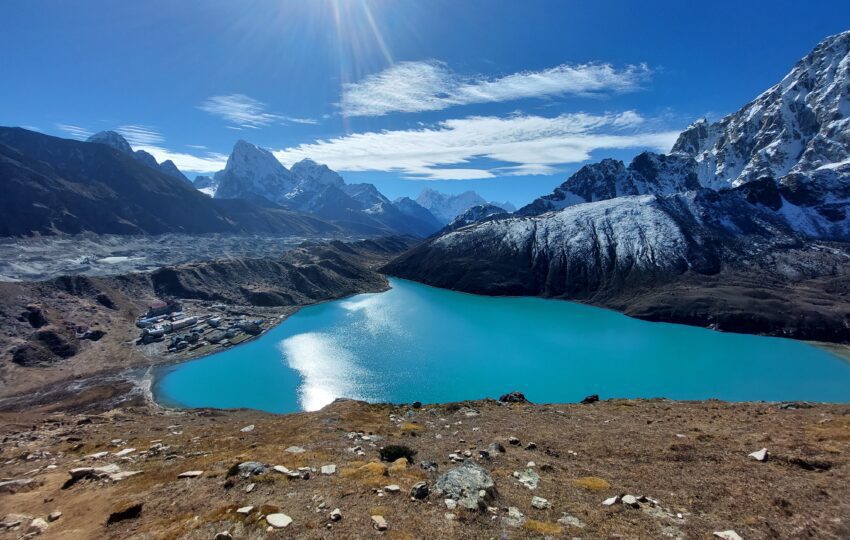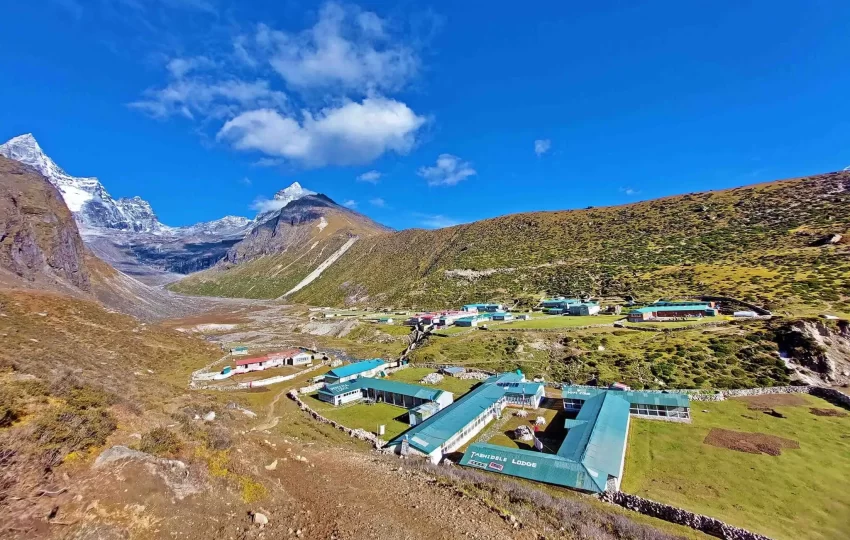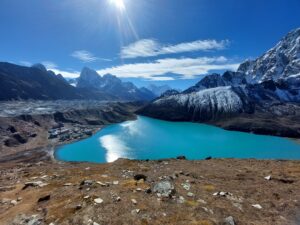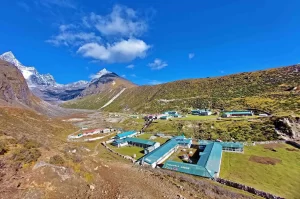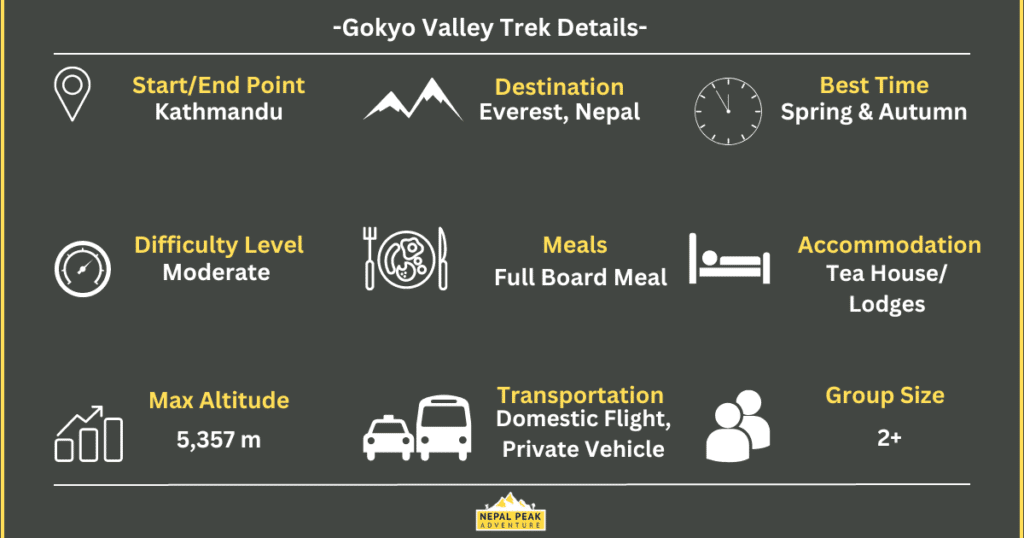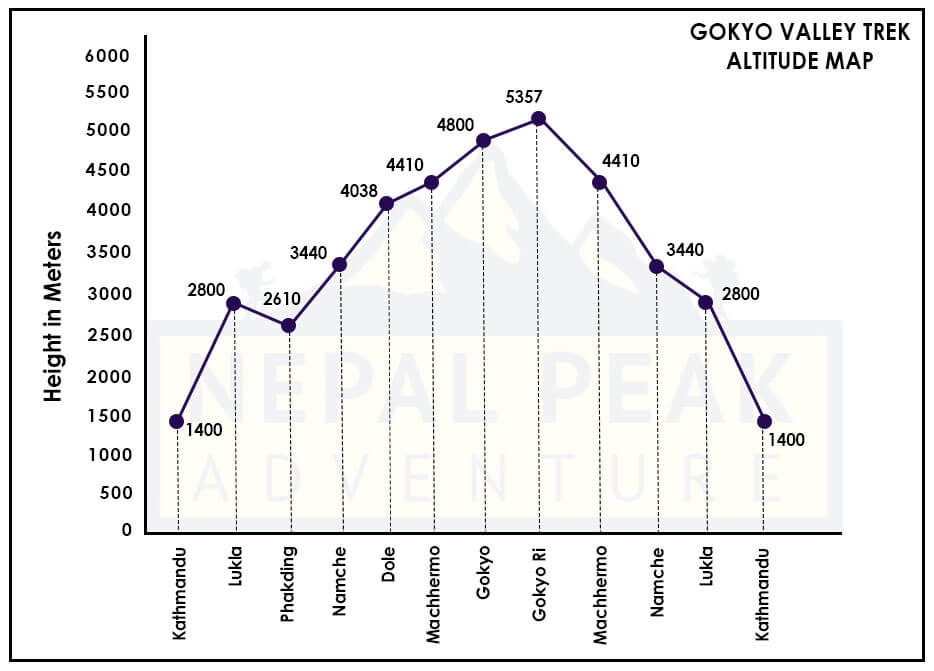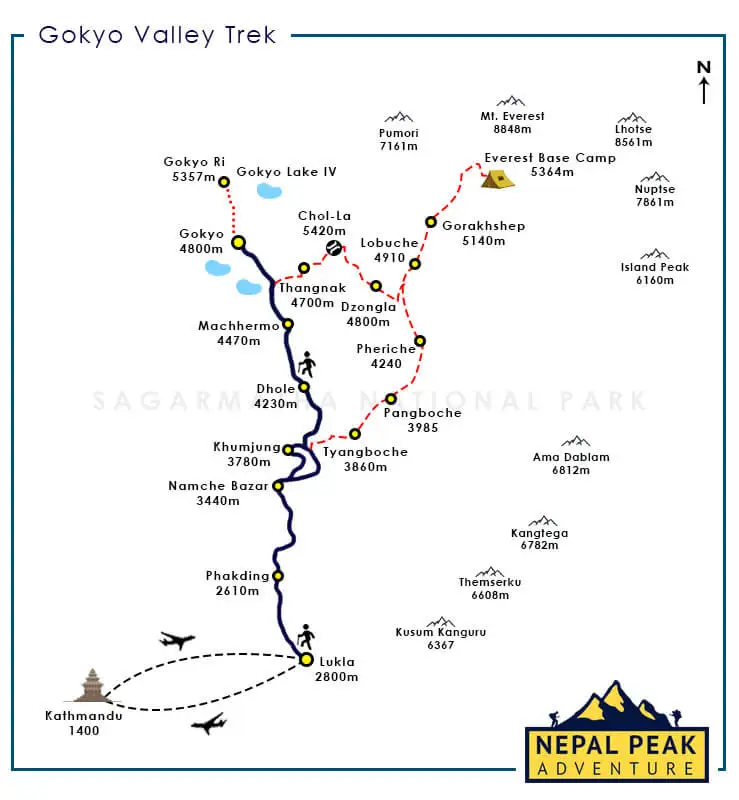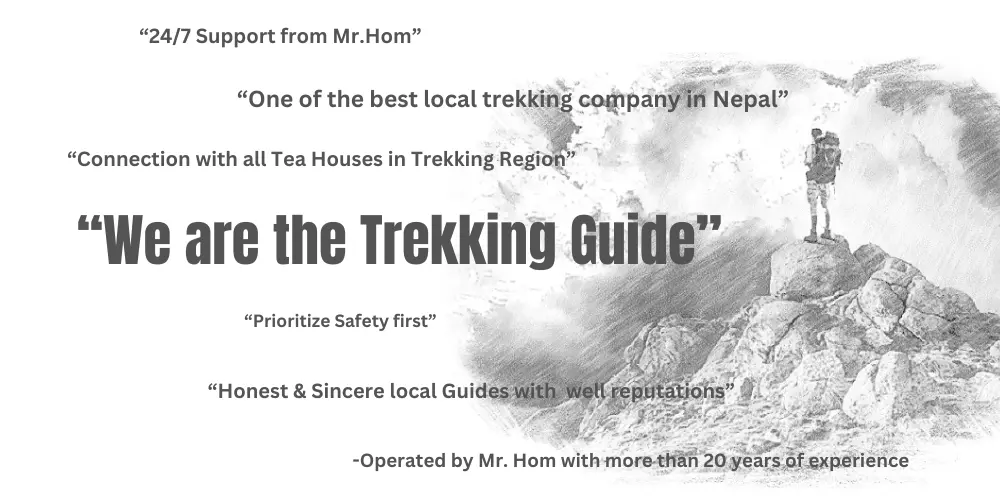The Gokyo Valley Trek is a popular trekking route in the Everest Region of Nepal that will take you to beautiful Gokyo Lake. The stunning views of the Himalayas range, Mount Everest, Cho Oyu, Makalu, and other peaks from Gokyo Ri are worth it. The trek also passes through the traditional Sherpa Village & offers cultural insights into local communities.
It is considered as moderate-level in terms of difficulty & takes 11-13 Days to complete depending on the itinerary. Here are the short details of Gokyo Valley Trek:
Gokyo Valley Trek Outline Itinerary:
- Day 01: Arrival in Kathmandu & Transfer to Hotel via Private Vehicle
- Day 02: Flight to Lukla & Trek to Phakding
- Day 03: Trek to Namche Bazar from Phakding
- Day 04: Acclimatization Day in Namche Bazar & Day Excursion
- Day 05: 5-6 Hours Walk to Dole from Namche
- Day 06: Trek to Machhermo from Dole (4-5 hours walk)
- Day 07: Reach Gokyo after 4-5 hours of walk
- Day 08: Acclimatization Day & Day Excursion
- Day 09: Hike to Gokyo-Ri & Trek back to Machhermo
- Day 10: Trek back to Namche Bazar
- Day 11: Trek to Lukla
- Day 12: Flight back to Kathmandu from Lukla
- Day 13: Departure Day from Kathmandu.
As shown from the itinerary, Kathmandu is your first destination which is at 1,400m altitude & the highest point you will trek to is 5,357m; Gokyo Ri. Here is a detailed altitude chart of the Gokyo Valley Trek managed according to the itinerary.
Now the most frequently asked question after seeing the chart is "How to prepare for the high-altitude trek?". Here are some quick tips for you:
- Always walk slowly during the whole trek even if you are descending.
- Do not skip the acclimatization day & hike to different places during the acclimatization day.
- Stay hydrated during the trek & do not skip meals.
- Have your oxygen level checked from time to time through an oximeter? Our guides always carry with them.
- Tell your guide if there are any changes in your health condition like no appetite, headache, vomiting, etc.
Gokyo Trek Cost Inclusion & Exclusion:
- Airport pick-up and transfer to your hotel via private vehicle
- Welcome dinner in a reputable Nepalese Restaurant with a live Nepali cultural program
- Two nights at standard accommodation in Kathmandu on the basis of Twin Sharing with breakfast ( Day 1 & Day 12)
- Domestic Transfer & Flight to Lukla from Kathmandu during the off-season
- Domestic Transfers & Flight to Lukla from Ramechhap during Spring & Autumn season
- Ramechhap Transportation Cost | Private Vehicle
- All Standard Accommodations during the trek (Teahouses/Lodges) | 5 nights room with attached bathroom with Hot Shower (1-night Phakding, 3 Night Namche, 1 night Lukla) | 5 nights in standard Tea Houses / Lodges
- All three meals: Breakfast, Lunch & Dinner while on the trek
- 3 cups of Tea/Coffee during the trek per day
- Seasonal Fruits after Breakfast
- Professional & Discipline Trekking guide
- Trekking Guide Costs such as Salary, Insurance, Documents
- Expenses of a porter (one porter for every two trekkers given)
- Salary, Insurance, and other minimal expenses of Porter
- Trekking Permits and any necessary documentation for the trek
- All taxes related to the trek as applicable.
- Down Jacket, sleeping bag, and a duffle bag (upon request) for the trekking purpose only
- One duffle Bag and a T-shirt as a souvenir
- Trekking map and a trekking completion certificate
- Group medical Kit Box
- Airport Transfer for Departure via Private Vehicle
- Arrangement of Emergency Helicopter evacuation service ( It should be covered by your insurance policy)
Exclusion:
- Nepal Visa fees
- International flight ticket to and from Nepal
- Meals in Kathmandu besides welcome dinner, farewell dinner, and breakfast
- The entire cost of beverages while on the trek & in Kathmandu
- Your travel insurance (must include Helicopter evacuation service)
- Tipping to the guide and porter
- Anything not included in the trip includes list is considered your personal expenses
Gokyo Valley Trek Map:
Gokyo Valley Trek Preparation & Difficulty
Gokyo Valley Trek is a moderate-level trek and easier than Everest Base Camp Trek. The higher elevation you will reach in Everest Base Camp is 5,545m while in Gokyo Valley Trek the highest elevation you will reach is 5,357m. Also, the day-to-day walk in the Gokyo Valley trek is shorter than the Everest Base Camp trail.
As for the preparation for the Gokyo Valley trek, anyone having general physical fitness can undertake this trek; however, we still recommend you have some outdoor activities a few months prior to embarking on the trek. It also depends on how your physical condition is now. For a fit & fine or athletic person, a 1-month training will be enough. For a normal healthy person, you need to focus on endurance, strength & flexibility which can take a minimum of 3 months. Again, it can take more than 3 months according on your location, health status, weight, age, and many more.
Contact Us if you want to share your present condition and ask us for professional tips.
Thus, it doesn't matter if you are old, young, fat, or thin. If you work out efficiently then you can do this trek. Here is the basic workout for everyone to prepare for the 5,357m altitude Gokyo Trek.
- Multi-Day hiking while carrying a backpack
- Running, Cycling, or Jogging while carrying some load on your back.
- Wall climbing activities
- Following a balanced diet
- Yoga & Meditating
Another thing to prepare for the Gokyo Valley Trek is the packing list which is very crucial. You should have good knowledge about how to pack things efficiently and what to pack in your backpack. You should also know how to choose the right gear for yourself and buy practical gear rather than expensive gear. Here, we have listed the fundamentals gears that are needed for the Gokyo Trek:
- Packing list for Head: Beanie, Warm Cap, Sunglass (UV protection), torch helmet, Buff, Hat for sunblock
- Packing list for Body: -30°C resistance Down Jacket, Thermal Underwear, Wicking Long-Sleeve, Warm Gloves, Quick Dry T-Shirts, Fleece Jacket, Trekking Pants, Shorts, Gaiters
- Packing list for Foot: Hiking Boot, Spare Shoes, Cotton socks, woolen hiking socks
- Other Essential gear: Sleeping Bag, Duffel Bag, Backpack, First Aid Box, Hot Water bag, Water Bottle, Trekking Pole, Portable Charger
These are the necessary gear for the trek. Similarly, some of the gears can be rented in Thamel, Kathmandu so you can cost control. If you have any other questions then you can always send us a message. Till then, best of luck with this beautiful Gokyo Valley Trek.
The Checkpoints of Gokyo Valley Trek:
Lukla & Namche Bazar
Nestled amidst the Himalayas, Lukla stands as the thrilling threshold to the Everest region, captivating adventurers with its unique charm and breathtaking landscapes. With an elevation of 2860m, Lukla is the starting point for you.
The journey begins with a spectacular flight to Tenzing-Hillary Airport, famously known as Lukla Airport – a heart-pounding experience as your plane navigates through the mountainous terrain to land on what is often considered one of the most challenging airports globally.
Whereas, Namche Bazaar stands as the gateway to the higher altitudes of Everest at an elevation of 3440 meters (11,352 feet). This bustling mountain town is not just a pitstop; it's a cultural and commercial hub, offering a blend of tradition and modernity.
Trekkers usually stop in Namche Bazar for a day to explore Local Markets, acclimatize in Everest View Hotel, visit the Sherpa Museum, or hike to Khumjung.
Gokyo Lake & Gokyo-Ri
Gokyo welcomes trekkers with a chain of pristine lakes, each shimmering with a surreal turquoise hue. The series of lakes, including the renowned Dudh Pokhari, mirror the towering peaks that surround them. Gokyo Cho is the main lake with an area of 42.9 ha (106 acres), and the village of Gokyo lies on its eastern shore.
Whereas, Gokyo Ri stands as the ultimate vantage point standing at an elevation of 5,357 meters (17,575 feet). The ascent to Gokyo Ri is rewarded with a 360-degree spectacle of some of the world's highest peaks. As the sun kisses the snow-capped giants, Everest, Lhotse, Makalu, and Cho Oyu unveil their majesty, creating a canvas of unparalleled beauty.
However, the climb to Gokyo Ri is a challenging yet exhilarating journey which makes this package an exciting adventure.
Insight to Gokyo Valley Trek: Useful Information
Transparency is important, and we at Nepal Peak Adventure try our best to give detailed information as much as possible to our clients. We believe, having prior knowledge about your trek can help you prepare your trek more efficiently. So, let's discuss how your trek starts, accommodation, and food during the trek, how to prepare as a beginner, and so on.
Booking with Nepal Peak Adventure:
Let’s say you are ready to book with Nepal Peak Adventure, so are the procedures for booking with us, and what roles do Nepal Peak Adv will play?So, the first thing is the detailed information that Nepal Peak Adventure will provide you about itinerary, departure dates, cost breakdown, and any other questions that you may ask.
After you are satisfied with your inquiry, you will then proceed with the online booking process reserving your seat with us which you can find in any package. Or, you can directly go to the online payment system for partial payment and pay only 25% of the total price.
We will then ask for some documents like your arrival dates in Nepal, and passport details to book a Lukla flight, reserve hotels in Kathmandu, and book tea houses.
First Day of Your Arrival: Renting Gears & Briefing
Your journey to the Gokyo Valley begins with anticipation and excitement as you touch down at Kathmandu International Airport.
Airport Welcome:
As per your arrival date, the Nepal Peak Adventure crew will extend a warm welcome upon your arrival at Kathmandu International Airport. After clearing immigration and collecting your luggage, you will be escorted to your hotel in Kathmandu.
If you want to know how to get On Arrival Visa in Nepal then follow the steps:
- Fill out the 'Arrival Card' upon arrival.
- Complete the 'Tourist Visa' Application
- Fill out the 'Tourist Visa' form online. You can either fill it out before your arrival by visiting the official website of the Department of Immigration or use the kiosk machines upon your arrival at the airport.
If you choose to fill out the form online, you will receive a submission receipt with a barcode. Print out the receipt and bring it with you to acquire the visa. This receipt is valid for fifteen days; after that, it becomes invalid, and you will need to fill out the form again.
Proceed to the bank to make the required payment based on your visa duration (15/30/90 days). Obtain the payment receipt for your records.
First Day of Your Arrival: Renting Gears & Briefing
Hotel Check-in:
- Upon reaching your hotel, you will have the opportunity to freshen up and rest after your journey.
Trek Briefing:
- In the afternoon or evening, you will attend a comprehensive trek briefing conducted by your trekking guide or by Mr. Hom Rana.
- The briefing covers essential aspects of the trek, including the itinerary, trekking route, expected weather conditions, and safety protocols.
Gear Rental:
- After the briefing, you will have the chance to review and rent any trekking gear you may need. We typically provide options for renting equipment like sleeping bags, down jackets, trekking poles, and more.
- Ensure that the rented gear fits well and meets your comfort and safety requirements.
Introduction to Kathmandu:
- If time permits, you may take a short orientation walk around Kathmandu, exploring nearby areas and becoming familiar with the local environment.
- This provides an opportunity to experience the vibrant culture and atmosphere of the bustling capital.
Dinner and Rest:
- The day concludes with a hearty welcome dinner from NPA, allowing you to savor Nepali cuisine and bond with your fellow trekkers.
Lukla Flight: Ramechhap or Kathmandu
The Lukla flight serves as the beginning of your Gokyo Valley trek, taking you into the heart of the Khumbu region. However, there are two primary departure points for Lukla flights—Kathmandu and Ramechhap—each with its dynamics and considerations.
Lukla Flight from Kathmandu:
Only during Off-Seasons, there will be a Lukla Flight from Kathmandu which offers the convenience of departing from the capital city, reducing travel time and logistics.
During bad weather, there will be no Lukla Flights, leading to delays or cancellations. Please Note that you should maintain flexibility in your trekking schedule, allowing for adjustments in case of flight delays or cancellations.
Lukla Flight from Ramechhap:
Flight from Ramechhap is fixed during peak season / trekking season. The journey from Kathmandu to Ramechhap involves an overland transfer of approximately 4-6 hours. This is a scenic drive through rural landscapes, allowing trekkers to experience Nepal beyond the capital.
Lukla Flight Time:
Lukla flights are subject to weather conditions, and disruptions are not uncommon. The availability of flights can vary based on the departure point. However, the first flight always starts at 7:00 am.
Luggage Limit and Costs:
The luggage limit for Lukla Flight is 10 kg luggage and 5 kg hand carry. For every extra weight, you may be charged an additional fee of $1 per kg.
First Day of Your Trek: How to Start Your Trek
The first day of your Gokyo Valley trek is a momentous step into the heart of the Himalayas. As you lace up your boots and embark on this adventure, here's a guide on how to kickstart your trekking experience:
Breakfast and Last-Minute Checks:
- The Lukla flight starts at 7:00 am. Conduct a final check of your backpack, ensuring you have all the necessary items and trekking essentials.
- Breakfast will be packed and your journey begins at Ramechhap Manthali Airport or Kathmandu Domestic Airport
Lukla Flight & Meet Your Guide and Porter:
- As per your flight schedule, you will take off to Lukla Airport via small aircraft that carry not more than 13-15 passengers at a time.
- Your trekking guide and porter, essential companions for your journey, will meet you at the designated meeting point.
Trail Head to Phakding or Namche Bazaar:
- The trail on the first day typically leads to Phakding according to the itinerary.
- The trek from Lukla to Phakding is a gentle descent and easy. However, after Phakding, the trek will be challenging.
Typical Day during Trekking:
The day begins with an early wake-up call, often before sunrise. The fresh mountain air and the promise of stunning views make it worthwhile to rise with the first light.
Before coming for breakfast, pack everything and leave the bag so that the porter can take it with him. Afterward, enjoy a warm cup of tea or coffee in the teahouse or lodge, accompanied by a hearty breakfast, and hit the trail early.
There will be many scenic viewpoints, prayer flags, or traditional stupas to capture in the photo but do not take more time.
Lunch Break:
- We will stop for a Lunch break at a teahouse in midday.
- Engage with local communities, observe daily life, and capture the unique cultural richness of the region.
After lunch, we will again resume our trek to reach the day’s destination and settle into a tea house or lodge, where basic yet cozy accommodations await.
Your guide will conduct an evening briefing, outlining the plan for the next day, discussing acclimatization strategies, and addressing any trek-related information.
Afterward, enjoy a delicious dinner featuring local and trekker-friendly dishes, or choose between different cuisines to meet your taste.
Finally, leave your order for the next morning's breakfast and get a well-deserved rest at your accommodation.
Tips for the Trek:
- Continuously hydrate to combat the effects of altitude and exertion.
- Maintain a steady pace, allowing for acclimatization and enjoyment of the surroundings.
- Embrace the local culture with respect and curiosity, fostering positive interactions.
Understanding the Accommodation & Meals on Your Trek
As you trek through the enchanting landscapes of the Gokyo Valley, your accommodation and meals play a crucial role in ensuring a comfortable and rewarding experience. Here's an overview of what to expect in terms of lodging and food during your Himalayan adventure & what we offer:
Tea Houses and Lodges:
- Along the trekking route, you'll primarily stay in tea houses or lodges. These are simple, family-run establishments that offer basic yet cozy accommodations.
- With Nepal Peak Adventure, you get 5 Nights in a quality tea house that has a Hot Shower & Attached Bathroom. ( 1 night in Phakding, 3 nights in Namche, & 1 night in Lukla).
- As other area has only basic accommodations, your 9 days will be in those basic accommodations.
Meals:
- Meals in tea houses are hearty and designed to replenish your energy after a day of trekking. Expect a mix of local and international dishes, often featuring rice, noodles, soups, and seasonal vegetables.
- Popular items include dal Bhat (lentil soup with rice), momos (dumplings), pasta, and a variety of snacks. The menu caters to both vegetarian and non-vegetarian preferences.
Breakfast:
- Breakfasts typically include options like eggs, toast, porridge, muesli, and local specialties. It's an essential meal to kickstart your day's trek with sustained energy.
Water and Hydration:
- Tea houses provide safe drinking water, which can be refilled using water purification tablets or by purchasing bottled water along the way.
Insight to Local culture & Understanding them
Trekking is not only about immersing in the breathtaking natural beauties but also about immersing yourself in the rich tapestry of local culture. The Sherpa community, renowned for their warmth and hospitality, welcomes trekkers with open hearts. If you want to greet them, use “Namaste” which symbolizes respect and acknowledgment as well as a welcoming gesture. While many locals understand English, learning a few basic Nepali phrases adds a personal touch. Simple greetings and expressions can go a long way in building connections.
Similarly, the Khumbu region is dotted with ancient monasteries, such as the Tengboche Monastery. If your trek coincides with local festivals, consider attending the celebrations.
Festivals like Mani Rimdu are vibrant occasions that provide a window into Sherpa customs, dances, and religious ceremonies.
Seek permission before taking photographs of individuals, particularly in more intimate settings. In conclusion, understanding local Sherpa culture adds a profound dimension to your Gokyo Valley trek.
Beyond the physical challenge and awe-inspiring scenery, it is the connections forged with the people of the Himalayas that make the journey truly transformative.
About the life of Guide & Porter
In the realm of Himalayan trekking, guides and porters are not just essential roles; they are the backbone of the trekking experience. Their lives intertwine with the trails, carrying the weight of logistics and providing invaluable support to trekkers. Let's delve into the intricacies of their lives and the pivotal roles they play:
The Guide's Life:
These individuals are not merely navigators of trails but also cultural ambassadors, storytellers, and safety guardians. From securing permits to arranging accommodation, guides handle logistical aspects, allowing trekkers to focus on the journey.
Why is it best to have a guide?
Navigational Expertise: Guides possess an intricate knowledge of the trails, ensuring trekkers stay on the right path and navigate challenging terrains.
Cultural Interpreter: Acting as cultural interpreters, guides offer insights into local customs, traditions, and share stories about the Sherpa way of life.
Safety Assurance: Guides are trained in first aid and altitude-related issues, providing a safety net for trekkers in case of emergencies.
Skills Guides Bring to the Trek:
- Guides often possess multilingual skills, facilitating clear communication between trekkers and locals.
- Proficient in map reading and GPS usage, guides ensure a smooth and secure journey along the trails. Well-versed in handling unexpected situations, guides play a crucial role in crisis management, whether it be sudden weather changes or health concerns.
- Guides offer a bridge between trekkers and the local culture, fostering meaningful interactions and a deeper understanding of the region.
The Porter's Contribution:
Porters, the unsung heroes of the trek, shoulder the physical demands of carrying trekking gear, supplies, and even trekkers' backpacks, allowing them to trek with less load.
Porter Contribution in the Trek:
- Porters carry heavy loads, ensuring trekkers can focus on the trek itself without the burden of excessive weight.
- Porters assist in setting up camp, including assembling tents and arranging necessary equipment for trekkers' comfort. (When necessary)
How much to Tip Guide & Porter
Tipping is a customary practice in the trekking community, a heartfelt way to show gratitude for the dedication and support provided by guides and porters throughout your Gokyo Valley trek.
However, if you want to tip a guide & porter then here is a guideline:
- On average, trekkers often tip guides between USD 10 to USD 15 per day. This amount can be adjusted based on your overall satisfaction, the duration of the trek, and the complexity of the itinerary.
- A typical tipping range for porters is USD 5 to USD 10 per day. Adjustments can be made based on the weight of the load carried and the overall difficulty of the trek.
- If your guide demonstrated exceptional knowledge, and navigational skills, and provided insightful cultural information, consider a higher tip.
- If your porter carried a heavier load or went above and beyond, a higher tip is a generous way to express appreciation.
When to Tip a guide and porter:
Tipping is typically done at the end of the trek, either on the last day or during a farewell ceremony. This allows you to assess the overall experience before expressing your appreciation.
